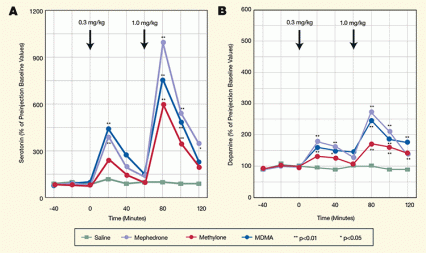Mephedrone and methylone, two stimulants commonly found in designer drugs such as “bath salts,” act on the brain much like methylenedioxymethamphetamine (MDMA, Ecstasy). According to recent studies, the two may be addictive, but may not have the same propensity for causing toxicity as MDMA.
 Figure 1A and 1B. Mephedrone and Methylone Increase Extracellular Serotonin and Dopamine Direct measurements of neurochemical release in the nucleus accumbens of living rats show that the higher the dose of mephedrone and methylone, the greater the increase in extracellular dopamine and serotonin levels. Like MDMA, the drugs produce a greater effect on serotonin (Figure 1A) than on dopamine (Figure 1B). Asterisks indicate a significant difference compared to saline-injected controls at a particular time point.
Figure 1A and 1B. Mephedrone and Methylone Increase Extracellular Serotonin and Dopamine Direct measurements of neurochemical release in the nucleus accumbens of living rats show that the higher the dose of mephedrone and methylone, the greater the increase in extracellular dopamine and serotonin levels. Like MDMA, the drugs produce a greater effect on serotonin (Figure 1A) than on dopamine (Figure 1B). Asterisks indicate a significant difference compared to saline-injected controls at a particular time point.
- Text description
-
Figure 1 shows a pair of line charts that show the effect of injections of mephedrone, methylone, MDMA and a saline control, on serotonin level, and on dopamine level. For serotonin, after an injection of 0.3mg/kg of each compound at time zero, serotonin levels rose after 20 minutes for the test compounds (MDMA 450% of the preinjection baseline value; mephedrone 400% and methylone 225%). By 60 minutes after injection, the serotonin levels for all 3 compounds had dropped back to the baseline value. Then, at 60 minutes, animals were given an injection of 1.0 mg/kg of the compounds. Serotonin levels at 20 minutes increased 1000% for mephedrone, 750% for MDA, and 600% for methylone over baseline values (saline injection). By 120 minutes, serotonin levels dropped to 350% for mephedrone, 225% for MDA and 200% for methylone.
In the dopamine chart, 20 minutes after a 0.mg/kg injection, dopamine levels at increased 180% of baseline for mephedrone, 155% for MDA, and 130% for methylone. At 60 minutes the dopamine levels were 175% of baseline for MDMA, 160% for mephedrone and back to baseline (100%) for methylone. Then after an injection of 1.0 mg/kg at 60 minutes, dopamine levels at 80 minutes increased to 275% of baseline for mephedrone, 245% for MDMA, and 170% for methylone. By 120 minutes dopamine levels had decreased to 175% for MDMA, 145% for mephedrone and 145% for methylone.
Dr. Michael Baumann of NIDA’s Intramural Research Program and researchers at several centers collaborated to pin down the drugs’ pharmacological and behavioral effects. The researchers sampled rats’ extracellular brain fluid while the animals moved about after being dosed with one of the three stimulants or saline. Assays of the fluid revealed that all the drugs elevated extracellular concentrations of the neurotransmitters dopamine and serotonin, as shown by comparison with levels in the animals given saline. For all three drugs, the impact on serotonin was greater than that on dopamine (see Figure 1A and 1B).
Analysis of rats’ brain tissue revealed an underlying mechanism for the heightened neurotransmitter presence: All three drugs caused transporters in cellular membranes to release dopamine and serotonin into the extracellular space. This effect reverses the normal activity of the transporters, which is to draw the neurotransmitters out of the extracellular space.
 Figure 2. Designer Drugs Are Chemically Related to MDMA Mephedrone, methylone, and MDMA all share the chemical structures shown in green.
Figure 2. Designer Drugs Are Chemically Related to MDMA Mephedrone, methylone, and MDMA all share the chemical structures shown in green.
- Text description
-
This figure shows the chemical structures of mephedrone, methylone, and MDMA. Parts of the molecules that are the same are green, and those that are different are gray. Mephedrone has an additional methyl group coming off a benzene ring and a ketone group on the carbon next to the ring. MDMA and methylone have a ring compound with two oxygen molecules coming off the benzene ring that mephedrone does not have. Methylone also has a ketone group in the same position as the mephedrone structure. MDMA does not have the ketone group.
The fact that the three drugs produce similar pharmacologic effects is consistent with their similar chemical structures (see Figure 2). However, the researchers also found important differences between the drugs.
Whereas repeated high doses of MDMA markedly reduced serotonin concentrations in the cortex and striatum, the researchers did not see this effect with mephedrone or methylone. Moreover, although rats given acute doses of all three drugs exhibited locomotor stimulation and hyperthermia, repeated high doses of the drugs produced different behavioral responses. Specifically, instead of the flattened body posture and forepaw treading seen with MDMA, mephedrone and methylone induced rearing behavior.
Dr. Baumann and colleagues note that much research has shown that drugs which increase extracellular dopamine—as do all the drugs they tested—have high potential for addiction. They speculate that the differences in rats’ serotonin and behavioral responses to the drugs are linked, and may indicate that mephedrone and methylone have less toxic potential than MDMA. However, they emphasize that this hypothesis needs to be tested.
This study was supported by NIH grants DA017675 and DA027191.
Source:
Baumann, M.H., et al. The designer methcathinone analogs, mephedrone and methylone, are substrates for monoamine transporters in brain tissue. Neuropsychopharmacology 37(5):1192–1203, 2012. Full Text
